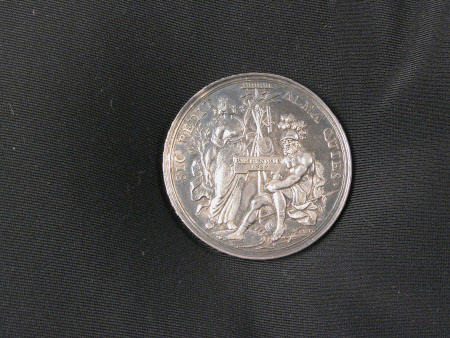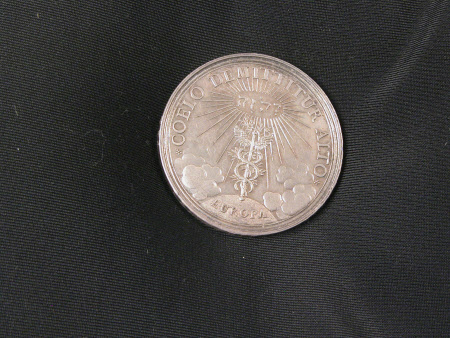Peace of Ryswick
Philip Heinrich Müller (1654-1719)
Category
Coins and medals
Date
1697
Materials
Silver
Measurements
454 mm (Diameter)
Place of origin
Nuremberg
Order this imageCollection
Osterley Park and House, London
NT 773290
Summary
Silver, medal commemorating the Peace of Ryswick, by Philip Heinrich Müller (1654-1719), struck Nuremberg, Germany, 1697. A silver medal made by Philip Heinrich Müller (1654-1719), commemorating the Peace of Ryswick in 1697. The obverse depicts the brooding god of war Mars, in armour, seated upon a pile of weapons, his foot upon his shield. In front of him a draped female figure, representing Peace, holds in her right hand an olive branch and in the other a gathering of tools for agriculture and husbandry. From them hangs a tablet inscribed ‘The Peace of Ryswick 1697’. The Latin legend translates as ‘Thus returns beloved quiet’. The artist’s initials, PHM, are at lower right. On the reverse is a caduceus around which are twisted olive branches, and which rests upon a globe marked ‘Europa’. Above the caduceus radiates the name ‘Jehovah’, written in Hebrew script. Clouds at left and right. The legend translates as ‘It is sent down from the lofty heaven’. On the edge there is a further inscription, translating as ‘A single Peace is better than innumerable triumphs.’
Full description
A German medal struck in the Imperial city of Nuremberg, to commemorate the completion of the Treaty or Peace of Ryswick. This was a series of treaties concluded in 1697 between France and a Grand Alliance consisting of Britain, Spain, the Holy Roman Empire and the United Provinces. Their purpose was to bring a peaceful conclusion to the War of the Treaty of Augsburg or ‘Nine Years War’ (1688-97). With hostilities spreading beyond Europe to North America and India, the Nine Years War is sometimes regarded as the first global conflict. Its roots lay in competition between France and the Holy Roman Empire over the question of who should eventually succeed to the throne of Spain. Spain, which had been the leading world power in the sixteenth century, had entered a long period of decline. In 1665 the frail Charles II, last of the Spanish Habsburg kings, had become king. Attempts to secure the question of his succession lasted for decades, but had proved fruitless. Louis XIV of France, an aggressively expansionist monarch, saw the possibility of uniting the French and Spanish thrones as a way of achieving his objective of making France the most powerful nation in Europe. On the other hand, the Habsburg Holy Roman Emperors, who had long been dynastically linked to the Spanish monarchs, were determined to prevent French encirclement, whilst they saw themselves as the legitimate successors to the Spanish throne. By 1697 all sides were exhausted after nine years of largely inconclusive hostilities. The Peace of Ryswick was mediated by the Swedish diplomat Niels Eosander, Baron of Lilliënrot, and sought to look forward to an extended period of peace. Negotiations and the signing of a series of separate peace treaties took place at King William III’s palace, the Huis ter Nieuburch at Rijswijk. The following treaties were signed in September and October 1697: 20 September 1697: Treaty of Peace between France and Spain 20 September 1697: Treaty of Peace between France and England 20 September 1697: Articles for the Suspension of Armed Conflict in Germany between France and the Holy Roman Empire 21 September 1697: Treaty of Peace and a Treaty of Commerce between France and the Dutch Republic 9 October 1697: Separate Article for the Dutch Republic 30 October 1697: Treaty of Peace between France and the Holy Roman Empire. The final Treaty, between France and the Holy Roman Empire, was the most problematic to negotiate and settle, since the Holy Roman Empire, under Emperor Leopold I, remained deeply suspicious of French intentions, and was desperate to gain advantage for the Austrian position concerning the succession to the Spanish throne on the death of Charles II of Spain; the Empire’s unwillingness to sign a peace treaty potentially threatened the position of the other members of the Grand Alliance. However, pressure from its allies caused it eventually to sign. The Peace required all territories captured by any side since 1688 to be handed back; the Dutch were allowed to hold eight 'barrier' fortresses in the Spanish Netherlands; Louis XIV promised to recognise William as the rightful king of Great Britain and Ireland and not to succour his enemies, whilst the town of Orange was also handed back to its ruling prince. This agreement did not force the French to hand back the extensive territorial gains they had made before 1688, nor did it require them to stand down their armed forces. Most importantly, it did not resolve the vexed question of the Spanish succession. So far as Anglo-French relations were concerned, Louis continued to offer shelter to the former King James II/VII and his court, calling into question his commitment to recognise William. Hopes of a lengthy period of peaceful coexistence following the meeting at Ryswick were therefore disappointed since in the event the peace lasted only until the death of Charles II of Spain in 1700. The French were subsequently seen to have used the Peace as an opportunity to regroup and strengthen their forces, which they kept at their wartime strengths. On his death, the childless Charles named as his successor Philip of Anjou, a grandson of Louis XIV, which he saw as the best solution to prevent Spain’s further decline. This led to the creation in 1701 of a new Great Alliance between the Empire, Britain and the Netherlands, in an attempt to bolster Austrian claims to the Spanish throne and to keep France within its borders. In 1702, the War of the Spanish Succession broke out, and lasted until 1713 and the Peace of Utrecht (for medals commemorating that treaty, see NT 773300-02). George Child Villiers, 9th Earl of Jersey (1910-1998) was a keen collector of ancient and modern coins and medals. He assembled an exceptionally large group of medals relating to the Peace of Ryswick, no doubt because of the involvement in the event of his ancestor Edward Villiers, first Earl of Jersey (c. 1655-1711). Villiers was a courtier, who had accompanied Princess Mary to the Netherlands in 1677, for her marriage to William of Orange. In May 1695, Jersey was appointed to the diplomatic post of Envoy-Extraordinary to the States General of the United Provinces, moving to the Netherlands. He played a full part in the peace conference at Ryswick, having been appointed Envoy-Extraordinary and -Plenipotentiary to the conference on 26 February 1697. Another Jersey ancestor, Sir Francis Child the Elder (1641/2-1713), was a goldsmith and banker, who helped to lay the basis for the family’s fortune. Child lent King William large sums for the financing of the Nine Years' War and was actively involved in negotiations for the treaty of Ryswick and also present for the signing of the various treaties. He bought a large number of Dutch and Flemish paintings whilst in the Netherlands in 1697. For medals in the Jersey collection commemorating the Peace of Ryswick, see NT 773284-773291, 773311. Jeremy Warren 2019
Provenance
Given to the National Trust in 1993 by George Child Villiers, 9th Earl of Jersey (1910-1998).
Marks and inscriptions
Obverse, legend: COELLO DEMITTITUR ALTO. Obverse, centre: תהווה Obverse, exergue: EUROPA Reverse, legend: SIC REDIT ALMA QUIES. Reverse, in tablet: PAX RYSWIC/1697 Reverse, bottom right: PHM Edge: PAX UNA TRIUMPHIS INNUMERIS POTIOR
Makers and roles
Philip Heinrich Müller (1654-1719), medallist
References
Hawkins, Franks and Grueber 1885: Edward Hawkins, Augustus W. Franks and Herbert A. Grueber (eds.), Medallic Illustrations of the History of Great Britain and Ireland to the death of George II, 2 vols., London 1885, vol. II, p. 162, no. 433.

